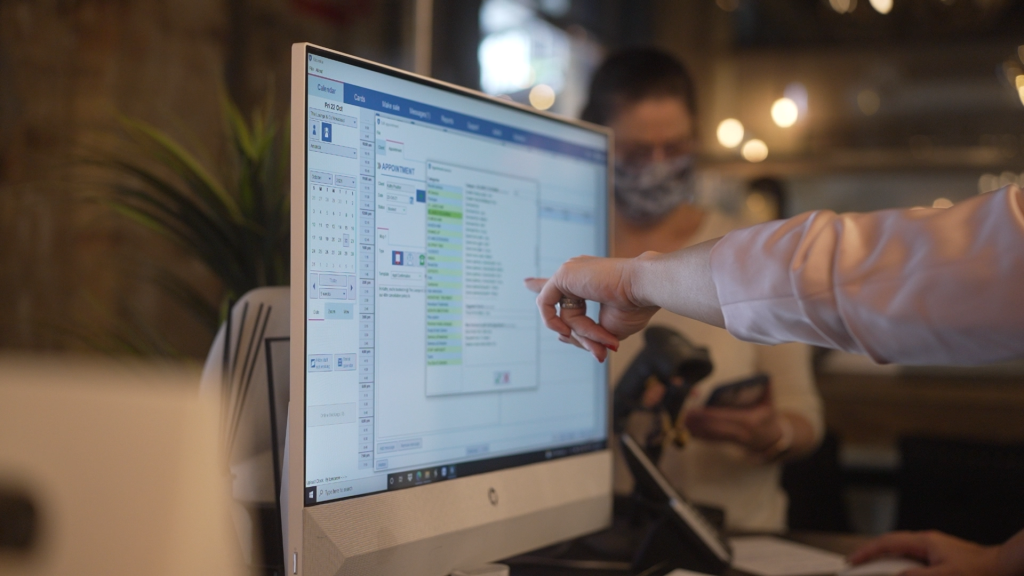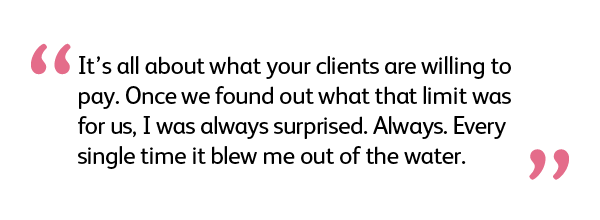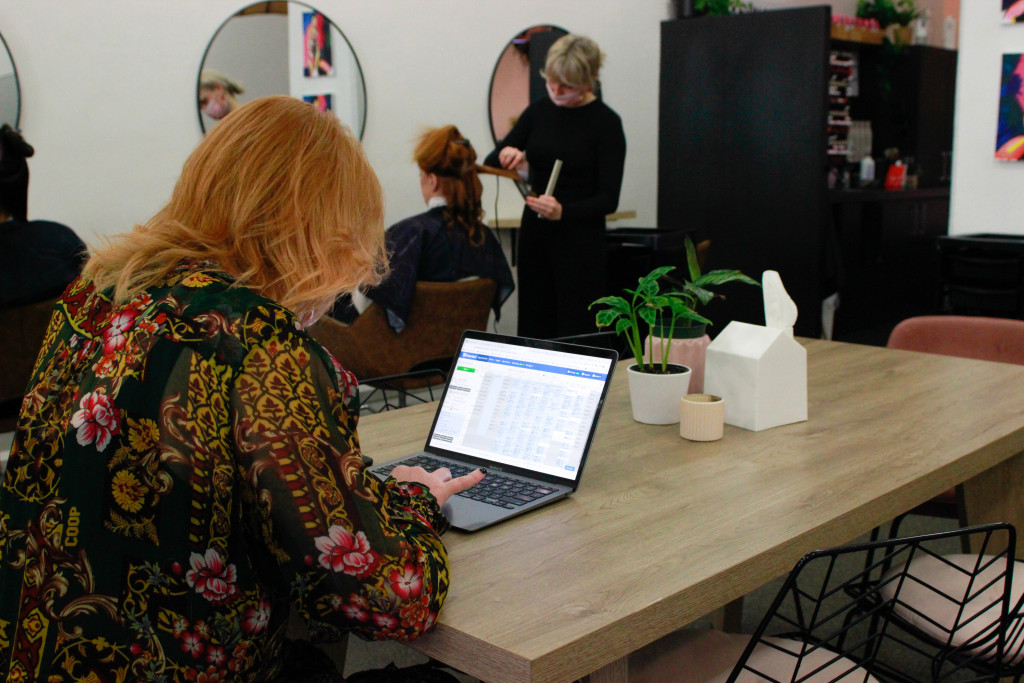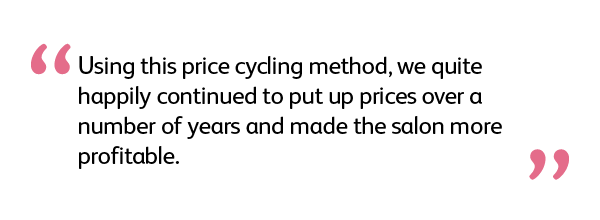“Price increases are topical for the wrong reasons” – Paul Carbis dives right into it in our most recent with chat with him. Heading up Carbis Business Management, Paul is an acclaimed salon business coach, a regularly practising skin therapist, and along with years of experience managing his own salon, his understanding of how the hair and beauty industry operates is well regarded.
Recently we sat down to chat with him about salon price increases. His fresh, original, and dramatically different approach is well worth taking the time to understand! Paul has been implementing what he calls his ‘price cycling’ strategy into hundred of salons across New Zealand and Australia for over 20 years, with minimal disruption.
Watch the full interview below, or read along to find out more about his unique pricing strategy and why it’s worth thinking about for your salon, spa or clinic.
Increasing your salon prices – a solid, steady strategy
“Just about every supplier over the last three months has put prices up. Whether it be in freight, or in product cost, there is no denying prices have gone up. Some of them have crept up a little bit whereas some have increased a lot, and we’ve also seen things like petrol prices go through the roof, grocery prices skyrocketing.
All of these increases are actually cutting into your salon margins, and yet many salon owners are wary of how their clients will react, or are too scared to put their prices up!
Those that do tend to implement across the board increases where everything goes up by 5%, 10%, 3%, they bring out new price lists, change it all on their website, and what’s more, they announce it to all their clients.
So now absolutely every single client knows that there’s been a price increase, and absolutely every client now looks and judges on pricing rather than just concentrating on getting great service.”
“Now, I think that’s the wrong response, and for the wrong reasons. I think a good part of managing every business should be increasing your prices regularly.”
Price cycling – what is it?
“It’s no secret I’ve always been opposed to across the board price increases, and I’ve always been opposed to announcing them as well. So what I developed was a way of testing how much I could increase prices by without having to communicate this with my clients. I didn’t do it as a reaction to economic hardship and I definitely didn’t do it because I wanted to swindle people. I did it because I wanted to maximise profits for the salon.
And at the time when I came up with price cycling I was a salon owner myself, so the objective was to maximise my own profits.
I started with the question of – how do I know how much someone is willing to pay for a service? And the answer was, I have no idea! I don’t know how much my clients are willing to pay for a really good service, and I wont know until I start testing the water.
So I developed the system I call price cycling.”
How does it work?
“One of the reasons I started doing this was because of the introduction of computer based salon and spa software like Kitomba, when I realised that I could very easily measure the number of treatments I was doing in a particular sector.
Once I was armed with the capability to accurately measure our salon treatments, plus motivation not to implement blanket price increases, I decided to test out what my pricing maximums would be, category by category through my salon menu.
I started with one sector at a time (ie massages, facials, waxing etc), and increased pricing ever so slightly – a $1 here, or $2 here, not enough to upset anyone. But enough that if I’m doing 50 or 60 of those treatments a week, that’s $60, and if you’re multiplying that by 50 weeks of the year, that’s an extra $3,000, which makes a huge impact to most hair and beauty businesses.
From there I just cycled through all my service sections one by one! Think of it like a pricing tornado, I started off little by little, and whole project just got bigger and bigger.
And when we had been right through the whole salon menu, I ran all of my reports to ensure we hadn’t dropped off total service numbers in any areas, and started the whole cycle over again.
This led us to discover what our maximum pricing was for each area; what people were willing to pay for outstanding service, great results, superior knowledge, the whole salon environment.”
Top tips for using price cycling
Know when to stop
“I would say keep price cycling until it starts to affect your total service numbers! You might find that over time, lots of sectors weren’t affected at all. And then you may discover that one sector numbers have dropped just a fraction, so I would suggest putting a hold on that and continuing with your other categories.
It’s all about what your clients are willing to pay. Once we found out what that limit was for us, I was always surprised. Always. Every single time it blew me out of the water. What people actually were willing to pay before they started to ask ‘is that dearer than normal’, or if your numbers start to drop back a little bit. It actually took a couple of years of cycling for us.”
What about telling my clients?
“Why do you need to? If I put up all my prices for eyes only and I don’t touch anything else on my price list, are my facial clients worried about it? No. My leg waxing clients worried about it? No.
Most clients won’t even notice or care, but this small, incremental increase is enough that over a twelve month period, it can be worth thousands of dollars to you and your salon business.
Put yourself in your clients shoes – if you normally pay $20 for a brow shape and I put it up to $22, would that be enough for you to choose not to come back?
For me personally it would have to go up a significant amount to go through the rigmarole of going and finding another business.”
Should I still use pricing menus?
“I’ve always been a bit of a fan of price menus, so I would recommend smaller print runs, or having the pricing on your website, instead of opting for the cheaper version of thousands at a time. I’d put the price of the next thing up and get some more printed, or if it’s on your website it’s easily amendable.
It’s enough to have a little disclaimer on your price menu or on your website to say “prices are subject to change”, or something similar.”
Keep good records
“Keep in mind, this price cycling strategy will only work if you keep good records – that’s the secret!
Having an efficient and effective salon software system that you can use to pull your records is key. You can use this to see what you’ve been doing numbers wise, and then you can test to see whether the price increases have had an effect or not in the months afterwards.”
Don’t let a few clients put you off
“There are always people that are going to grizzle over a dollar or two, but they’re not the people you want in your salon anyway.
If these small price increases mean that hardly any of your clients notice, or if they do, they don’t really care because the amount was so small, then where’s the problem? And the answer is, there isn’t a problem.
People are loyal in beauty and because of that, it’s got to be some sort of really significant price rise for them to choose to take their business elsewhere. They are more likely to choose to go elsewhere because of poor service or because you didn’t keep in touch or that they didn’t feel like they were important than by a small price increase.”
Moral of the story
“What I also found beneficial about this strategy was that you were able to absorb little increases from your suppliers throughout the year. That increase in freight charge, or product cost was no longer so daunting and threatening to your salon because you were able to continually just touch it up along the way.
It’s a better system because you’re not announcing that you’re continually putting prices up. It means that you’re reaching maximum amounts that you can for your services. It means that you’re testing the water on a regular basis, which is just good business, and increasing your profits at the same time.
We were perpetually surprised at what people will pay, and I think most salon owners would be too. It didn’t have anything to do with our competitiors, we were just focusing on what we were doing, and the services and client experience we had to offer.
Using this price cycling method, we quite happily continued to put up prices over a number of years and made the salon more profitable. I think a regular pricing strategy, no matter what it is, needs to be done as good business practice, not just a reactive approach because we’re in hard times.
Price increases don’t have to be that one-off, scary, everyone’s-going-to-notice, have-to-communicate it affair. Cycling through your services one by one, little by little is just a really nice way of approaching pricing, and managing a successful future.”
Are you running a salon or spa software that can crunch the numbers for you? Book a free demo with Kitomba to see how our all inclusive software can help grow your business.
Read next:









